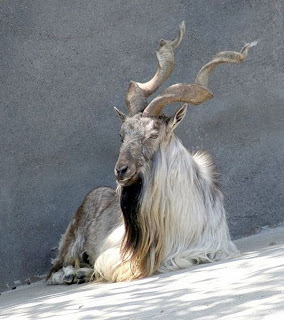Interesting Facts about Markhor Goat
Scientific Name: Capra falconeri
Other Names and/or Listed subspecies: 3 subspecies endangered:
- Chiltan Markhor or Chiltan Wild Goat (Capra falconeri chiltanensis or Capra aegagrus chialtanensis),
- Straight-horned Markhor (Capra falconeri jerdoni),
- Kabul Markhor (Capra falconeri megaceros)
Group: Mammals
Status/Date Listed as Endangered:
EN-US FWS: June 14, 1976
EN-IUCN: 2008
Size:
Head-body length: 140 - 180 cm
Male weight: 80 - 110 kg
Female weight: 32 - 50 kg
Area(s) Where Listed As Endangered:
Afghanistan, Pakistan
The markhor is an Asian mountain goat species found in the
western Himalayas. You really can’t miss the Markhor since they are one unique
looking goat. Besides the long furry
coat the Markhor also has unusual horns.
The spiraled horns of the male can grow as long as 1.5 m (4.9′). Meanwhile the horns of the female are
not nearly as impressive as they typically grow to about 50 cm (1.9′). Personally, I would have been impressed with
the 2 foot horns on the female if it weren’t for the 5 foot long male horns.
Markhors weigh between 88 and 243 lb, and males are larger than
females. The average body length is 55
to 70 inches. Their coats are grizzled light brown to black in color (depending
on the subspecies), and the coats of males are usually lighter than that of
females. In the summer, their coats are short and smooth, and in the winter
they grow longer and thicker. Males have long hair on their chin, throat,
chest, and shanks, and females have smaller fringes. Both male and female have
tightly curled, corkscrew-like horns that start close together at the head and
spread out toward the tips, but the horns of males grow about six times longer.
Typically these goats can be found on the mountains ranging
anywhere from 600 -3600 m above sea level in scrub forests made up of primarily
oaks, pines, and junipers. They are mainly active in the early morning and late
afternoon. They graze mainly during the spring and summer feeding on a variety
of grasses. During the autumn and winter months, they eat leaves, twigs, and
shrubs. Males are solitary and females and their young live in herds of around
nine. Mating occurs in the winter, and males fight for breeding rights by
lunging and locking horns to make the other lose its balance. Females give
birth to one to two young after a gestation period of 135 to 170 days.
Three markhor subspecies are endangered: the Chiltan markhor
or Chiltan Wild Goat (Capra falconeri chiltanensis) found in Pakistan, the
Straight-horned markhor (Capra falconeri jerdoni) found in Afghanistan and
Pakistan, and the Kabul markhor (Capra falconeri megaceros), also found in
Afghanistan and Pakistan. The Chiltan markhor may also be called Capra aegagrus
chialtanensis because there is much controversy regarding its classification as
aCapra falconeri subspecies, and some argue that it is a subspecies of the wild
goat (Capra aegarus). All three subspecies are threatened due to hunting by
humans. Their horns are prized among trophy hunters and used in the Asian
medicine market. They also compete with domestic livestock and local
agriculture for habitat. All three subspecies were listed as endangered in
1976, but there are no other known conservation plans for the species.











